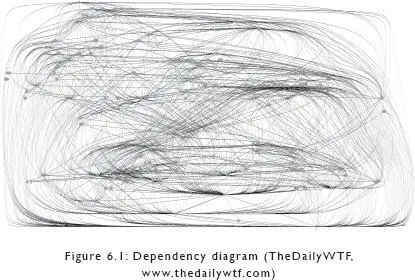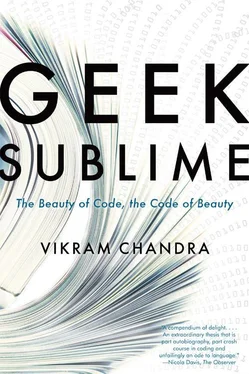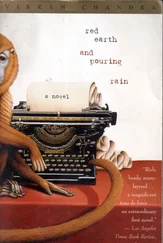
So rasa is what I felt that afternoon I discovered Hemingway at our kitchen table in Bombay, when the bleak undertow of his stories, roiling with unspoken emotion, flung me into an exaltation, a state of delight. Hemingway’s famous taut rhythms, the stripped simplicity of his diction, those repetitions of sound that he meticulously builds into his prose, all these enhance the iceberg-sized dhvani of what he leaves unsaid. Every word, every pause, every hesitation makes the dhvani of a story.
Flannery O’Connor writes:
The meaning of a story has to be embodied in it, has to be made concrete in it. A story is a way to say something that can’t be said any other way, and it takes every word in the story to say what the meaning is. You tell a story because a statement would be inadequate. When anybody asks what a story is about, the only proper thing is to tell him to read the story. The meaning of fiction is not abstract meaning but experienced meaning. 58
The only way to explain to you what I experienced when I first read Hemingway is to tell you to read those stories. And even then, you will read different stories. We may read the same texts, but the dhvani that manifests within you will be unique. Your beauty will be your own. If you reread a story that you read ten years ago, its dhvani within you will be new. Poetry’s beauty is infinite.
This is what ugly code looks like:
This is a dependency diagram — a graphic representation of interdependence or coupling (the black lines) between software components (the gray dots) within a program. A high degree of interdependence means that changing one component inside the program could lead to cascading changes in all the other connected components, and in turn to changes in their dependencies, and so on. Programs with this kind of structure are brittle, and hard to understand and fix. This dependency program was submitted anonymously to TheDailyWTF.com, where working programmers share “Curious Perversions in Information Technology” they find as they work. The exhibits at TheDailyWTF are often embodiments of stupidity, of miasmic dumbness perpetrated by the squadrons of sub-Mort programmers putting together the software that runs businesses across the globe. But, as often, high-flying “enterprise architects” and consultants put together systems that produce dependency diagrams that look like this renowned TheDailyWTF exhibit. A user commented, “I found something just like that blocking the drain once.”
If the knot of tangled hair in figure 6.1 provokes disgust, what kind of code garners admiration? In the anthology Beautiful Code , the contribution from the creator of the popular programming language Ruby, Yukihiro “Matz” Matsumoto, is an essay titled “Treating Code as an Essay.” Matz writes:
Judging the attributes of computer code is not simply a matter of aesthetics. Instead, computer programs are judged according to how well they execute their intended tasks. In other words, “beautiful code” is not an abstract virtue that exists independent of its programmers’ efforts. Rather, beautiful code is really meant to help the programmer be happy and productive. This is the metric I use to evaluate the beauty of a program. 1

He goes on to list the virtues of good code: brevity; reusability (“never write the same thing twice”); familiarity (Ruby is an “extremely conservative programming language” that does not use “innovative control structures” but “sticks to traditional control structures programmers are familiar with”); simplicity; flexibility (which Matz defines as “freedom from enforcement of tools,” so programmers aren’t forced to work in a certain way by the tools or languages they use); and, finally, balance: “No element by itself will ensure a beautiful program. When balanced together and kept in mind from the very beginning, each element will work harmoniously with the others to create beautiful code.” 2
So, beautiful code is lucid, it is easy to read and understand; its organization, its shape, its architecture reveals intent as much as its declarative syntax does. Each small part is coherent, singular in its purpose, and although all these small sections fit together like the pieces of a complex mosaic, they come apart easily when one element needs to be changed or replaced. All this leads to the happiness of the programmer, who must understand it, change it, extend it. This longing for architectural coherence leads to comparisons of code with music, which is often described as the most mathematical of the arts. There is, in fact, an anecdotal but fairly generalized belief among American programmers that there is a high correlation between coding and music-making, that many coders are musicians. A similar claim is made about mathematicians and music. These connections seem culturally encoded to me, specific to America — I’ve never heard of Indian programmers or mathematicians having a special affinity for music, apart from some being passionate listeners. Still, the code-and-music analogy is illuminating in that both practices prize harmonious pattern-making and abhor cacophony, a loss of clarity and structure. The snarl in the dependency diagram (figure 6.1) may strike the civilian as a pretty picture, with its swirl of lines and punctuating sparks of gray; to the programmer, it is an abomination because it speaks of incoherence, incomprehensibility, unpredictability, sticky seams of connection that prevent swift diagnosis and make excision and replacement all but impossible.
With his emphasis on programmer happiness, Matz makes explicit his allegiance to Donald Knuth’s literate programming. He writes:
Programs share some attributes with essays. For essays, the most important question readers ask is, “What is it about?” For programs, the main question is, “What does it do?” In fact, the purpose should be sufficiently clear that neither question ever needs to be uttered … Both essays and lines of code are meant — before all else — to be read and understood by human beings. 3
The trouble of course is that as software programs grow bigger and more complex, the code they comprise tends to become unreadable and incomprehensible to human beings. Programmers like to point out that if each line of code, or even each logical statement (which may spread to more than one physical line), is understood to be a component, software systems are the most complicated things that humans have ever built: the Lucent 5ESS switch, used in telephone exchanges, derives its functionality from a hundred million lines of code; the 2008 Fedora 9 distribution of Linux comprises over two hundred million lines of code. 4No temple, no cathedral has ever contained as many moving parts. So if you’ve ever written code, you understand in your bones the truth of Donald Knuth’s assertion, “Software is hard. It’s harder than anything else I’ve ever had to do.” 5If you’ve ever written code, the fact that so much software works so much of the time can seem profoundly miraculous.

Software is complicated because it tries to model the irreducible complexity of the world. Even a simple software requirement for a small company that, say, provides secretarial services for the medical insurance industry—“We need an application that makes it easier for our scribes to write up reports from doctors’ examinations of insurance claimants”—will always reveal a swirling hodgepodge of exceptions and special cases. Some of the doctors will have two addresses on file, some will have three, and this one was on Broadway until January 22 and in the East Village afterwards. A report will always begin with a summary of the patient’s claimed condition, unless it’s being written for Company X, which wants a narration of the doctor’s exam up front. There are four main types of boilerplate text for the doctor’s conclusions, but there needs to be a “freeform” option, and room for other templates, but creation of new templates needs to be restricted to certain users. And so on, and on, and on.
Читать дальше














